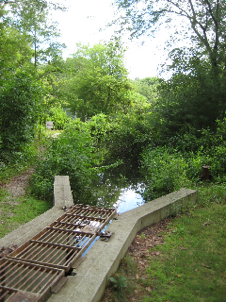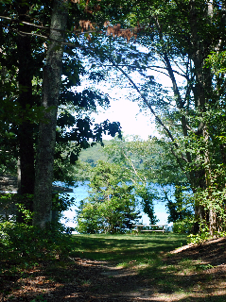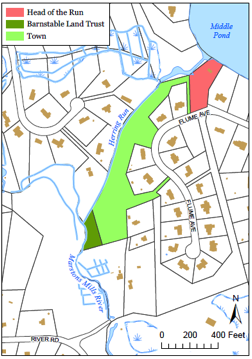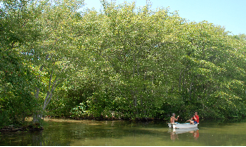
Helping the Endangered Herring Run
by Jaci Barton, Executive Director, Barnstable Land Trust
The annual herring migration is a natural wonder. For centuries, people have watched in awe as hundreds of thousands of herring migrated from the ocean upstream to spawn in freshwater ponds, drawn by some unseen force of nature.
Today, the once plentiful river herring are being considered for listing under the Endangered Species Act. The dramatic decline in the herring population has many wondering if this is a specter of things to come. Could river herring be the aquatic equivalent of the "canary in a coal mine"?
Up and down the Eastern Seaboard, herring have played a vital role in our culture and environment, and they connect us directly to our heritage.

River herring were caught by Native Americans, eaten, dried and planted with crops as fertilizer to help create a bountiful harvest. Those same practices were adopted by the colonists. The dried and pickled herring provided the early settlers with essential protein to survive Cape Cod's harsh winters.
Moreover, herring play a crucial role in the marine, estuarine and freshwater systems they inhabit, bringing much needed food for animals after the lean winter season.
On Cape Cod, birds such as gulls, herons and endangered roseate terns feed heavily on these migrating fish. Osprey, too, rely on a vibrant population of herring to feed themselves and their chicks. Seals also love to dine on herring!
Their importance to the fishery cannot be overstated. Herring are highly prized as recreational fishing bait because they are forage fish for many larger species, including bass and the very cod for which our famed peninsula is named. Maintaining a healthy, robust population of river herring is vital for the survival of larger sea creatures and the overall balance of the ecosystem.
Think Global, Act Local
Herring that have migrated as much as 1200 miles find their way to Nantucket Sound. Many swim into Barnstable's 3-bay estuary of Cotuit Bay, West Bay and North Bay. Miraculously, they arrive at the Marstons Mills River, the most visible and active herring run in the town. They then travel up a two-mile stretch of the River, resting briefly in the Mill Pond at Routes 149 and 28. The last "leg" of their journey takes them up a 1200-foot fishway to their spawning grounds in Middle Pond.
The late Kevin Galvin, who lived next to the Mill Pond, led the annual herring counts. Kevin described the yearly springtime return in his blog:
"The only time the aptly-named Herring Gull is on Mill Pond is when the herring are running. I don't even have to look; I just listen. Sometimes the gulls show up a few days early and poke around. There isn't any noise because there's nothing to fight over. But when the herring arrive, the fighting and screeching begin. As with many animals, the easiest way to find food is to try to steal it from one who's already found it. That unmistakable screech is notice to me to get the folks out to start counting."
Providing Safe Passage
Wanting to ensure that the herring have safe passage for the generations yet to come, Barnstable Land Trust (BLT) accepted the challenge to preserve a critical 1.17-acre parcel at the headwaters of the Marstons Mills River. It is the last remaining undeveloped parcel along the fishway that leads the herring to their spawning grounds in Middle Pond. Our goal is to raise $335,000 before June 30th. Thanks to a community that cares, we're already more than halfway there!
Saving this irreplaceable piece of land from development will complete the protection of land along the fishway and provide permanent access to the run to allow removal of shifting sands that often block passage into the pond. And because the land will be kept in its natural state, it will safeguard our water quality as well.
Overfishing is a global issue that affects the entire circle of life. While scientists, regulators and higher authorities propose new conservation measures to rebuild the adult spawning population, BLT can and is taking action locally.
By protecting the last undeveloped parcel along the fishway, we'll be able to maintain the herring run, ensuring safe passage to the herring's historical spawning grounds. Then when the population rebounds, the herring's habitat will be intact and the magical cycle of nature will continue.
All Photographs and Herring Run Map
Courtesy of BLT


Become a Herring Expert!
Did you know…?
- River herring (alewives and bluebacks) are anadromous, meaning they live primarily in saltwater but migrate upstream to freshwater lakes and ponds to spawn.
- Herring return to the waters where they hatched, possibly using sense of smell as a guide.
- Once at her spawning destination, a female deposits 60,000-300,000 eggs.
- After fertilization by the males, the eggs sink to the pond bottom and attach to stones or vegetation. The fertilized eggs hatch within a month's time.
- By early fall, the two to four-inch juveniles migrate to the sea. Less than one percent of the fertilized eggs survive to make the fall migration.
- Alewives can live up to a decade and grow to 10 inches long; the larger bluebacks (13 inches) can live 7 to 8 years.
- Reports of fishways to help fish migrate date back to 17th century France. The first fish ladder in the US was built in 1880 at the Pawtuxet Falls Dam in Rhode Island.
- Massachusetts is one of only four states (including North Carolina, Connecticut and Rhode Island) that have implemented strong management measures to protect dwindling stocks of river herring. Measures focus on protecting fish in coastal waters within their jurisdiction, but do not address the vulnerability of herring at sea where they spend most of their life. Federal action is needed!
Barnstable Land Trust is a private nonprofit organization established in 1983. Its mission is to preserve the unique character of Barnstable for future generations through the acquisition and conservation of open spaces and natural resources, wetlands, woodlands, wildlife and water quality in the seven villages of Barnstable. Currently the steward of 983 acres in the town of Barnstable, BLT will soon reach the 1000-acre LANDmark!
For more information about how to "Help the Herring Run" and other land-saving initiatives, or to learn about membership, events and volunteer opportunities, contact Barnstable Land Trust at BLT@cape.com, visit www.BLT.org or call 508-771-2585.
 |
